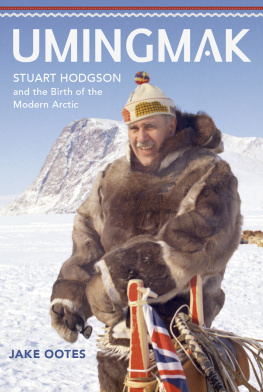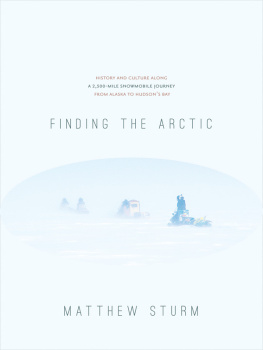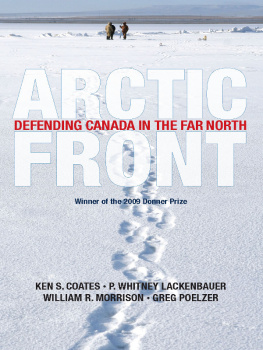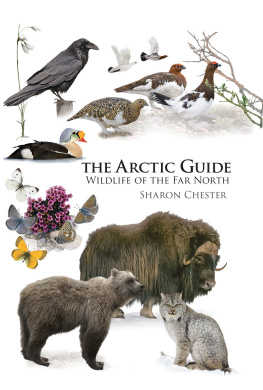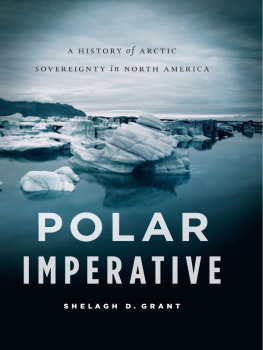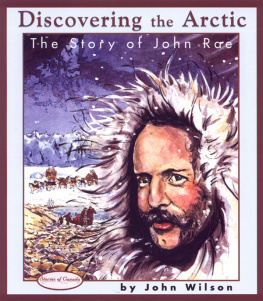
W HITE F OX AND I CY S EAS IN THE W ESTERN A RCTIC
THE LAMAR SERIES IN WESTERN HISTORY
The Lamar Series in Western History includes scholarly books of general public interest that enhance the understanding of human affairs in the American West and contribute to a wider understanding of the Wests significance in the political, social, and cultural life of America. Comprising works of the highest quality, the series aims to increase the range and vitality of Western American history, focusing on frontier places and people, Indian and ethnic communities, the urban West and the environment, and the art and illustrated history of the American West.
EDITORIAL BOARD
Howard R. Lamar, Sterling Professor of History Emeritus, Past President of Yale University
William J. Cronon, University of WisconsinMadison
Philip J. Deloria, University of Michigan
John Mack Faragher, Yale University
Jay Gitlin, Yale University
George A. Miles, Beinecke Library, Yale University
Martha A. Sandweiss, Princeton University
Virginia J. Scharff, University of New Mexico
Robert M. Utley, Former Chief Historian, National Park Service
RECENT TITLES
Sovereignty for Survival: American Energy Development and Indian Self-Determination, by James Robert Allison III
George I. Snchez: The Long Fight for Mexican American Integration, by Carlos K. Blanton
White Fox and Icy Seas in the Western Arctic: The Fur Trade, Transportation, and Change in the Early Twentieth Century, by John R. Bockstoce
Growing Up with the Country: Family, Race, and Nation after the Civil War, by Kendra Taira Field
Grounds for Dreaming: Mexican Americans, Mexican Immigrants, and the California Farmworker Movement, by Lori A. Flores
The Yaquis and the Empire: Violence, Spanish Imperial Power, and Native Resilience in Colonial Mexico, by Raphael Brewster Folsom
The American West: A New Interpretive History, Second Edition, by Robert V. Hine, John Mack Faragher, and Jon T. Coleman
Legal Codes and Talking Trees: Indigenous Womens Sovereignty in the Sonoran and Puget Sound Borderlands, 18541946, by Katrina Jagodinsky
Gathering Together: The Shawnee People through Diaspora and Nationhood, 16001870, by Sami Lakomki
An American Genocide: The United States and the California Indian Catastrophe, 18461873, by Benjamin Madley
Home Rule: Households, Manhood, and National Expansion on the Eighteenth-Century Kentucky Frontier, by Honor Sachs
The Cherokee Diaspora: An Indigenous History of Migration, Resettlement, and Identity, by Gregory D. Smithers
Wanted: The Outlaw Lives of Billy the Kid and Ned Kelly, by Robert M. Utley
First Impressions: A Readers Journey to Iconic Places of the American Southwest, by David J. Weber and William deBuys
W HITE F OX AND I CY S EAS IN THE W ESTERN A RCTIC

The Fur Trade, Transportation, and Change in the Early Twentieth Century

John R. Bockstoce
Foreword by William Barr

Published with assistance from the income of the Frederick John Kingsbury Memorial Fund.
Published with assistance from the foundation established in memory of Philip Hamilton McMillan of the Class of 1894, Yale College.
Copyright 2018 by John R. Bockstoce. Foreword 2018 by Yale University. All rights reserved. This book may not be reproduced, in whole or in part, including illustrations, in any form (beyond that copying permitted by Sections 107 and 108 of the U.S. Copyright Law and except by reviewers for the public press), without written permission from the publishers.
Yale University Press books may be purchased in quantity for educational, business, or promotional use. For information, please e-mail (U.K. office).
Original maps by Bill Nelson.
Set in Electra type by Integrated Publishing Solutions. Printed in the United States of America.
Library of Congress Control Number: 2017951820
ISBN 978-0-300-22179-4 (hardcover : alk. paper)
A catalogue record for this book is available from the British Library.
This paper meets the requirements of ansi/niso Z39.48-1992 (Permanence of Paper).
10 9 8 7 6 5 4 3 2 1
To John J. Burns and John C. George, friends and colleagues of fifty years

O THER P UBLICATIONS BY J OHN R. B OCKSTOCE
Furs and Frontiers in the Far North: The Contest among Native and Foreign Nations for the Bering Strait Fur Trade (2009)
High Latitude, North Atlantic: 30,000 Miles through Cold Seas and History (2003)
Arctic Discoveries: Images from Voyages of Four Decades in the North (2000)
Arctic Passages: A Unique Small Boat Voyage through the Great Northern Waterway (1991, 1992)
The Journal of Rochfort Maguire, 18521854. Two Years at Point Barrow, Alaska, aboard H.M.S. Plover in the Search for Sir John Franklin (editor) (1988)
Whales, Ice, and Men: The History of Whaling in the Western Arctic (1986, 1995)
American Whalers in the Western Arctic (with William Gilkerson) (1983)
The Voyage of the Schooner Polar Bear: Whaling and Trading in the North Pacific and Arctic, 19131914 by Bernhard Kilian (editor) (1983)
The Archaeology of Cape Nome, Alaska (1979)
Steam Whaling in the Western Arctic (1977)
Eskimos of Northwest Alaska in the Early Nineteenth Century: Based on the Voyage of HMS Blossom in 1826 and 1827 (1977)
C ONTENTS
by William Barr

F OREWORD
Soon after the establishment of Soviet (Bolshevik) control of Kamchatka and Chukotka in 1923, the international boundary between the Soviet Union and the United States (Alaska), running between Big and Little Diomede islands in Bering Strait, became a total barrier between two worldspolitically, socially, and commercially. But prior to that date the entire immense area from the Kolyma River in the west to Boothia Peninsula in the east possessed a remarkable degree of unity in economic terms, initially through Native trade networks and later through the American-European fur trade. As with his earlier work Furs and Frontiers in the Far North (2009), which deals with that trade until 1900, Bockstoces present work embraces this enormous area.
The fur trades supply routes reached their farthest extent to the eastthat is, from Bering Strait or the Mackenzie Riverin 1937, with the establishment of the Hudsons Bay Companys Fort Ross at the east end of Bellot Strait. It is therefore entirely appropriate that the opening chapter in Bockstoces book deals with the establishment (and short life) of that trading post.
Next page


